|

fabrics
& sewing
basic
medieval
clothing
sewing
tutorials
eyelet
tutorial
buttonhole
tutorial
cloth
button
tutorial
lucet
cord
tutorial
tassel
tutorial

|

Sewing
Tutorial:
Early Medieval Gown With Really Wide Sleeves

This picture shows Kim wearing
the gown with not-too-wide sleeves as she needed to work in it.
We lined the gown with pink silk in the sleeves so when she turned
the cuffs back, the silk was revealed.
Re-enactors use a slightly more complicated pattern with underarm
gores and a separate sleeve, but to make a slightly cheaty one
which requires less sewing, you can cut the sleeve-underarm all
in one piece.
Made out of silk, it's gorgeous for feasts! This should not be
worn alone. It should be worn with tight sleeves of your undergown
covering your bare arms underneath.
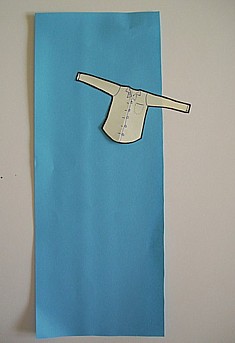 |
Step
1
You need: your fabric, pins, scissors and a cotton shirt for
sizing.
Don't use a stretchy one as it can give a false sense of how
it will fit you.
If you don't have a cotton shirt, get thee to an Op Shop and
spend a couple of dollars and get one. You need something
with sleeves so you can work out how long your sleeves will
need to be. |
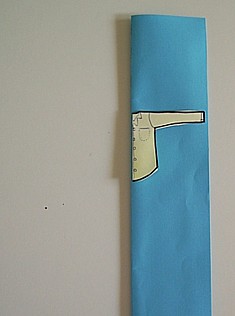 |
Step 2
Fold your shirt and your fabric in half lengthways.
The good side of the fabric is on the inside.
If you arm goes to the edge of the fabric, HOORAY, you can
make this with very little fabric at all. If your fabric
is skinny, you will need to fold your fabric double (two
runs of fabric instead of a folded over piece) before you
begin.
Your folded shirt matches the side with the folded fabric
on the left hand side.
|
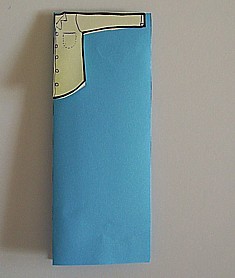 |
Step
3
After you have your fabric folded vertically from the previous
step, fold your long, skinny folded fabric horizontally the
other way so you have one fold where your shirt centre fold
is and one fold at the top of the sleeve.
You should have your one piece of fabric folded in four. The
neck hole of your shirt is where the corner is.
Not sure what I mean?
Check the next picture to double check that you've folded
it right. |
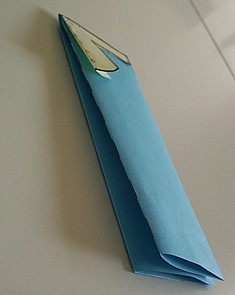 |
Step
4
Looking at it from a different angle to double check you've
folded your fabric the right way before you cut anything.
Your loose corners are at the bottom right.
Your corner fold where everything meets is at the top left
where your head hole is.
Your shirt is sitting right in that corner ready to mark out
your dress. |
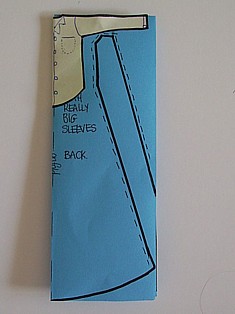 |
Step 5
Marking out your pattern.
Always, ALWAYS cut the seams a bit bigger than you think
you need. You can always take a dress in but it's really
hard to add pieces in once it's cut.
Your pattern is based around your non-stretchy shirt. Because
it pulls on over the head, you need to allow extra room
at the sides.
The underarm curves up and the sleeve follows your shirt
to the elbow and then down to the edge of the fabric to
about waist height.
Your outer sleeve seam
is on the fabric edge and doesn't even need hemming unless
you want to!
To get the size of your skirt for your lower gown, draw
a line from the hip (the bottom of the shirt) to the very
edge of the fabric. The wider your fabric, the more skirt
you'll have.
Your centre seam is as long as you are to the ground. If
you want a train, allow more on one side. If you're doing
this for the first time and want a rain at the back, cut
the entire gown long front and back and trim the front later
on once you have it on. It's much easier that way.
|
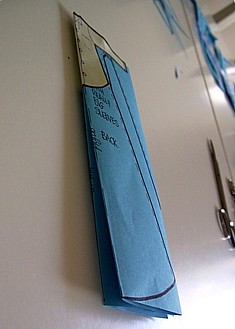 |
Step
6
Just double check again that the fabric is folded the right
way before you pin anything.
.. it should look like this... all the loose corners are in
the lower right hand side?
okay, start pinning!
Time to do some cutting! Just double check again that the
fabric is folded the right way before you cut anything...
it should look like this..
Yes? Get cutting! snip snip! |
 |
Step
7
Cut your new dress out.
This pic just shows your shirt unfolded.
Unpin the side now that your dress is cut. |
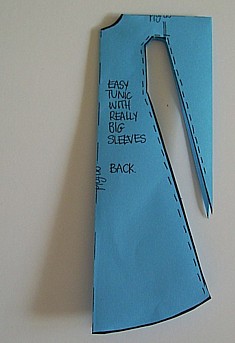 |
Step 8
Take your shirt away.
It looks like this now.
At this point, it's
exactly the same front and back.
|
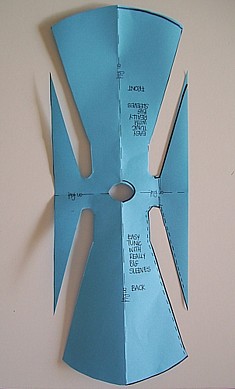 |
Step
9
Unfold your dress altogether. When it's spread out of the
floor, it looks like this.
Choose the side you want to be the front and cut the neckline
a little lower. Just a little. Remember, you can take more
off, but it's really hard to put it back on.
Okay so now you have a front. The seam with the dotted line
running horizontally through the neckline is where you fold
your dress now.
Remember to fold the fabric so the good side of the fabric
is on the inside. |
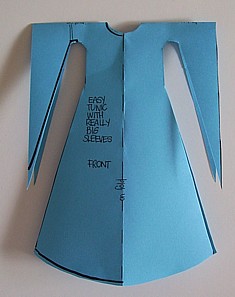 |
Step 10
If you've folded correctly, you now have a dress which looks
like this. Double check time: before you pin the side seams,
make sure the good sides of the fabric are facing each other.
Pin, pin, pin those
side seams all the way from the hem, along the body, under
the arms and down the sleeves.
Now very, very carefully check you can get it on over your
head. If it's very loose through the body, take the side
seams in a little. Try it on again. Still loose? Pin in
again and try it on. Remember, it will be a little loose
so you can pull it on over your head.
Once you're happy with the fit and you've adjusted your
neckline, sew your two side seams and you're finished!
|
|
|
The
finished result
Your new overgown will hang like a sack a little at first,
but don't be depressed. When you put your belt on, it will
pull in at the waist like it does in medieval manuscripts.
Add a pretty hood and pouch and you're all dressed!
Remember, it's an overgown. You need an undergown with fitted,
long sleeves to go underneath it.
If you are lining the sleeves, like Kim and I did on her gown
at the top of the page, you need to cut two of the sleeves
and stitch them together. It's a little complicated. It's
possibly easier to line the entire gown by making two and
sewing them together!
Happy sewing! |

Copyright
© Rosalie Gilbert
All text & photographs within this site are the property of
Rosalie Gilbert unless stated.
Art & artifact images remain the property of the owner.
Images and text may not be copied and used without permission.
|